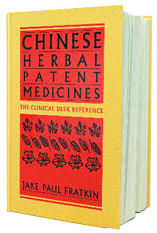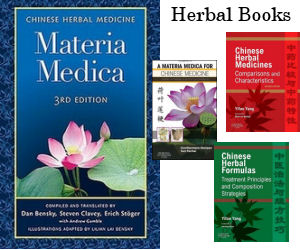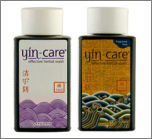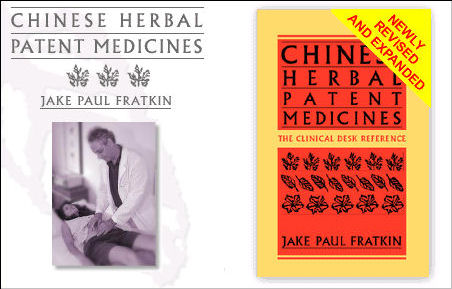Acupuncture & TCM Articles

Articles by Jake Paul Fratkin, OMD, LAc
Jake Fratkin, OMD, LAc, has been in the practice of Oriental medicine since 1978. Following undergraduate and graduate training at the University of Wisconsin in Chinese language and philosophy and pre-medicine, he pursued a seven-year apprenticeship in Japanese and Korean style acupuncture with Dr. Ineon Moon and a two-year apprenticeship in Chinese herbal medicine with Drs. Zhengan Guo and Pak-Leung Lau in Chicago. He also spent a year in Beijing hospitals interning in advanced herbal medicine, specializing in gastrointestinal and respiratory disorders, and pediatrics.  Dr. Fratkin is the author of several books, including Chinese Herbal Patent Medicines: The Clinical Desk Reference, and is the editor-organizer of Wu and Fischer's Practical Therapeutics of Traditional Chinese Medicine. In 1999, he was named the "Acupuncturist of the Year" by the American Association of Oriental Medicine.
Dr. Fratkin is the author of several books, including Chinese Herbal Patent Medicines: The Clinical Desk Reference, and is the editor-organizer of Wu and Fischer's Practical Therapeutics of Traditional Chinese Medicine. In 1999, he was named the "Acupuncturist of the Year" by the American Association of Oriental Medicine.
Chinese Herbal Patent Medicines: The Clinical Desk Reference
Hardback book, 1198 pages. This volume covers 1360 products, including 550 GMP level products and all of California FDB analysis on 505 products. Includes information on endagered animals, heavy metals, and pharmaceuticals. The text is organized into 12 groups, with a total of 109 chapters and includes material by Andrew Ellis, Subhuti Dharmananda, and Richard Ko. Over 80 pages of full-color photos (with English and Chinese cross-reference). Fully indexed.
An Extraordinary Chinese Herbal Product Finds its Way to North America
Many of China´s remarkable herbal products have been exported to the United States for years; Gan Mao Ling, Yunnan Pai Yao, Huang Lian Su, Ching Wan Hong and so on. So, it is refreshing to find a premier Chinese herbal product that has never been exported to the United States finally find its way here. It arrived here through the stubborn persistence of an American practitioner awestruck by the usefulness and effectiveness of the product.
The product is imported and packaged as Yin-Care by ArborUSA. In China it is known as Jie Er Yin Xi Ye, literally “Clean Your Yin Wash-Liquid’. It is popular in China on a level rivaling America´s successful over-the-counter products. Millions of bottles are sold yearly, mostly for vaginitis and as a topical anti-fungal.

The Medical Research.
Yin-Care, under its Chinese name, has been the subject of over 100 medical or hospital studies, including the following. In a study on acne performed by the Department of Dermatology at the Dalian Medical College, the effectiveness rate using Yin-Care topically was 82.7%, compared with a control group using topical sulfur, at 19%.
A study was performed on trichomonas vaginalis, the organism responsible for the most common type of vaginitis, at the 1st Affiliated Hospital of the Fujian Medical College, in 1991. The microbe was incubated with a 10% solution for ten minutes, in which all strains died.
At Kunming Medical University, in a study for chronic urinary tract infections due to chlamydia infection, patients in the treatment group used a 10% solution of Yin-Care as a wash once every evening for 14 days in succession. Patients in the control group were treated with tetracycline. The Yin-Care group showed a 97% cure rate, while the tetracycline group showed a 67% cure rate.
The Sichuan Provincial People´s Hospital, in a year-long study during 1991- 1992, examined 687 patients with thirteen various types of skin disorders. All patients were treated with topical dressings of 3% Yin-Care solution, changed four times daily. Results included the following effectiveness rates: Eczema 74.7%, pediatric eczema 67.9%, allergic dermatitis 76.2%, herpes zoster 51.5%, impetigo 88.2%, tinea infection 62.2%.
The Burn Department at the Daqing hospital did a study on 310 burn patients treated with Yin-Care, with a control group using similar burns on opposite parts of the body. A 5% to 34% solution of Yin-Care was applied directly to the burns, then wrapped with 12 to 16 layers of dry gauze. Yin-Care and dry gauze were reapplied every two days. The control group area used gauze soaked with either an oil extraction of Radix Lithospermum (Zi Cao) or with sulfadiazine argentum. The total rate of infection of the Yin-Care group was 10%, compared with a 44% rate of infection in the control group.
Finally, in a study done by the Institute of Dermatology of the Chinese Academy of Medical Sciences in 1991, in-vitro antimicrobial actions of Yin-Care were evaluated. Eight strains of bacteria and 18 strains of fungi were subjected to Yin-Care in various dilutions. The study aimed to determine the lowest concentration of Yin-Care to arrest the growth of each respective microbe. Nearly all of these bacterial and fungal cultures were neutralized by concentrations of Yin-Care ranging from 1.6% to 6.25%. 1
Origins and Manufacture.
The Yin-Care formula is said to originate in an old Daoist formula from the area around Chengdu. It was used as a bath four times per year to prepare for seasonal changes while avoiding pathogenic factors. (Because Chengdu is hot and humid, topical fungal infections and other skin conditions may have been prevalent.) A spiritual devotee, Xue Yongxin, was authorized by his Daoist teacher, Zheng Guoli to make the formula available to the people of Chengdu. Mr. Xue started manufacturing in 1982. By 1991, hospital studies began to confirm its efficacy as a topical application, and the government approved the product for hospital distribution. By last year, 80-100 million bottles a year were being sold around China. is said to originate in an old Daoist formula from the area around Chengdu. It was used as a bath four times per year to prepare for seasonal changes while avoiding pathogenic factors. (Because Chengdu is hot and humid, topical fungal infections and other skin conditions may have been prevalent.) A spiritual devotee, Xue Yongxin, was authorized by his Daoist teacher, Zheng Guoli to make the formula available to the people of Chengdu. Mr. Xue started manufacturing in 1982. By 1991, hospital studies began to confirm its efficacy as a topical application, and the government approved the product for hospital distribution. By last year, 80-100 million bottles a year were being sold around China.
The modern manufacture of Yin-Care is state of the art. Fourteen herbs are used, each tested with high density gas chromatography to ascertain their authenticity. The herbs are chopped and soaked in huge vats, then are heated for two hours to distill out essential oils. These oils are captured, bound in an emulsifier, and added in after the other herbs are cooked, condensed and filtered. Finally, a special proprietary hypoallergenic fragrance is added. The use of the essential oils is important, and the medicinal effects of the herbs could not be obtained by water extraction alone.
The Formula.
Yin-Care contains the following herbs: Fructus Cnidium Monnieri (She Chuang Zi), Herba Mentha (Bo He), Flos Lonicera (Jin Yin Hua), Fructus Gardenia (Zhi Zi), Cortex Phellodendron (Huang Bai), Radix Scutellaria Baicalensis (Huang Qin), Radix Sophora Flavescens (Ku Shen), Fructus Kochia (Di Fu Zi), Herba Artemisiae Yinchenhao (Yin Chen Hao), Radix Angelica Pubescens (Du Huo), Rhizoma Atractylodes (Cang Zhu), Rhizoma Acorus Gramineus (Shi Chang Pu), Folium Artemisia Argyi (Ai Ye), Cortex Pseudolarix (Tu Jing Pi).
These herbs serve a variety of functions. Cnidium She Chuang Zi, the lead herb, is known for its antifungal effects. Jin Yin Hua, Zhi Zi, Huang Bai, Ku Shen, and Yin Chen Hao all possess strong antimicrobial actions. The other herbs move damp and dispel wind. Kochia Di Fu Zi is well known for its ability to stop itching. Pseudolarix Tu Jing Pi, an unusual herb, is also used to kill parasitic microbes.
Yin Care Herbal Wash
  This is China's most widely used topical/intravaginal wash for gynecological as well as general bacterial, fungal and viral skin complaints. This is China's most widely used topical/intravaginal wash for gynecological as well as general bacterial, fungal and viral skin complaints.
The formula is comprised of both the water-extracted and essential oil materials of the herbs listed below and can be quite effective in small concentrations (5-10%).
It can be effectively applied as a wash, rub, sitz bath or compress.
Daniel Hudson's Story
Daniel Hudson is a most unusual fellow. A trained practitioner of acupuncture and herbal medicine, he left a busy practice in Denver to visit China. While visiting a friend in Chengdu, he came across the remarkable popularity of Jie Er Yin Xi Ye, and was surprised that he had never seen it in the USA. Allowed to visit the factory, he made friends with the manufacturing staff, and went on to spend 6 weeks at the factory, learning all about its specialized manufacturing process. Determined to import the product, he returned home and spent a small fortune seeking approval at various state and federal levels, including the FDA. In China, he had randomly selected three products from a pharmacy, a clinic and a hospital, and brought them for lab analysis at the USC¬San Diego´s School of Pharmacy. They confirmed that all three bottles were identical, and without drugs or pharmaceuticals of any kind. He won FDA approval for importation, as well as making sure that it passed California Proposition 65. Daniel started a company ArborUSA to import the product, and continues to have USC analyze his imports. He has been setting up distribution in the United States with various distributors, and is opening markets in Canada, Europe and the Middle East.
A Case Example.
I have tried out the product on several patients. One was a 56-year old male with a very stubborn case of tinea cruris. In his case, we had a fungal rash that had spread from his groin to his knee along his inner thigh, and on both buttocks. The rash was red, with the itching most active at the advancing borders, where the fungus was spreading. The condition had been progressively getting worse for the six months prior to his first visit.
The patient had resisted taking western antifungal medicines, and we treated him internally for fungus with herbs and western nutritional products. The rash was unresponsive to internal herbal/nutritional anti-fungals. Topical over-the-counter steroid creams were helpful in relieving itch and reducing the red markings, but the effect would be short lived, perhaps 12 hours at most.
I had given him one of my own herbal washes for fungal skin itching. It included three of the herbs used in the Jie Er Yin Xi Ye formula.2 My wash was somewhat helpful in relieving the itch and reducing heat and redness, but the response showed no accumulative effect.
With Yin-Care, the patient reported very good results, with redness and itching disappearing after 2 or three days of application. Still, it took about three weeks of daily application, at 35% concentration, to resolve the problem. Overall, I became quite impressed with this herbal wash. I have also used it in several cases of vaginitis, all to good effect.
Yin-Care is available in 4 oz bottles of concentrated liquid. I would highly recommend it for practitioners treating vaginitis or skin infections. Information about Yin-care can be found from the importer, Daniel Hudson, at arborusa.com. is available in 4 oz bottles of concentrated liquid. I would highly recommend it for practitioners treating vaginitis or skin infections. Information about Yin-care can be found from the importer, Daniel Hudson, at arborusa.com.
------------------------------------
1 All of these studies are discussed in detail in the research publication Yin-Care Symposium on Dermatology, Obstetrics and Gynecology. Chengdu, China, 1992. Abstracts are available as a pdf file from www.arborusa.com
2The formula I used for a decocted wash was equal parts of the following: Fructus Cnidium (She
Chuang Zi), Cortex Phellodendron (Huang Bai), Radix Sophora Flavescens (Ku Shen), Herba
Houttuynia (Yu Xing Cao), Radix Pulsatilla (Bai Tou Weng), Radix Isatis seu Baphicacanthus
(Ban Lan Gen), Herba Artemisia annua (Qing Hao), Radix Benincasa (Dong Gua Ren), Herba
Agrimonia(Xian He Cao).
Yin Care Herbal Wash
  This is China's most widely used topical/intravaginal wash for gynecological as well as general bacterial, fungal and viral skin complaints. The formula is comprised of both the water-extracted and essential oil materials of the herbs listed below and can be quite effective in small concentrations (5-10%). It can be effectively applied as a wash, rub, sitz bath or compress. This is China's most widely used topical/intravaginal wash for gynecological as well as general bacterial, fungal and viral skin complaints. The formula is comprised of both the water-extracted and essential oil materials of the herbs listed below and can be quite effective in small concentrations (5-10%). It can be effectively applied as a wash, rub, sitz bath or compress.
Dry and transform dampness, clear heat and toxin, purge fire, cool blood, disperse wind and stop itching, reduce swelling, detoxify skin lesions, promote circulation. Use at varying concentrations both topically and intravaginally for dampness, damp-heat, toxic-heat and wind gynecological patterns with or with out discharge including leucorrhea, vaginitis, cervicitis, gonorrhea, vulvovaginitis, S.T.D.ís, as well as general inflammations, infections and itching. Also used for various damp-heat, wind-damp and heat dermatological patterns such as psoriasis and eczema, shingles, rashes, cold sores, fungal foot afflictions, styes and acne. In small concentrations and applied as a compress to facilitate the healing of burns.
 
|
